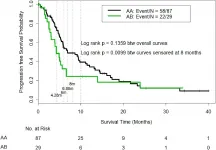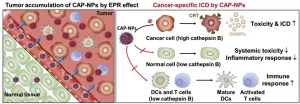(Press-News.org) DALLAS, June 28, 2021 -- People who must spend $1,000 or more annually in out-of-pocket medical deductibles under their health care insurance plan were less likely to seek care in the ER for chest pain and less likely to be admitted to the hospital during these visits, compared to people who have health insurance plans with an annual deductible of $500 or less, according to new research published today in the American Heart Association's flagship journal Circulation.
Chest pain can occur when the heart muscle doesn't get enough oxygen-rich blood. It may feel like pressure or squeezing in the chest. The discomfort also can occur in the shoulders, arms, neck, jaw or back and may also feel like indigestion. Chest pain may be a symptom of an underlying heart problem, usually coronary heart disease (CHD). There are many types of chest pain, and all chest pain should be checked by a health care professional.
Health insurers and employers who administer their own health plans are increasingly shifting the cost burden of health care to patients, researchers noted. By 2020, more than half of U.S. employees were enrolled in a high-deductible health plan, according to the national Employer Health Benefits Survey. Previous research has shown that insurance status and financial concerns affect patients' decisions to delay or skip seeking care for many medical conditions.
"Shifting the high cost of health care from insurers and employers to patients has become a trend across the U.S.," said lead study author Shih-Chuan Chou, M.D., M.P.H., S.M., an emergency care physician in the department of emergency medicine at Brigham and Women's Hospital in Boston. "Our study is one of the first to examine the impact of a high-deductible health care plan on people's decisions to go to an ER for chest pain."
Using the claims database from a nationwide U.S. health insurer, researchers identified patients ages 19 to 63, enrolled between 2003 and 2014, whose employers offered only low-deductible health plans ($500 or less/year) in the first year and then mandated enrollment in a high-deductible health plan ($1,000 or more/year) during the second year. The control group included members who were enrolled in a low-deductible health plan for two straight years.
The study included more than a half-million employees in the high-deductible group and nearly six million employees in the control group. In both groups, the average age was 42; about half of the participants were women, and about two-thirds were non-Hispanic white adults.
Researchers matched people in both groups according to patient-specific demographic and clinical characteristics and employer characteristics (such as the total number of employees) to ensure similarity. They examined whether switching to a high-deductible health plan changed employees' use of the ER for chest pain during the first year (the low-deductible year) compared to the second year (the high-deductible year). They also compared changes in annual patient outcomes from year one to year two between the high-deductible health plan group and the matched control group (those with low-deductible plan for two consecutive years).
Researchers found:
Switching to a high-deductible health plan was associated with a 4% reduction in ER visits for chest pain.
Enrollment in a high-deductible health plan was associated with an 11% decrease in ER visits for chest pain leading to hospitalization.
Among low-income patients, those who had high-deductible health plans were nearly one-third more likely to have a heart attack during a subsequent hospitalization 30 days after their initial ER visit for chest pain.
"People with higher deductibles delay treatment and are sicker when they show up in the ER for chest pain," Chou said. "When people with low-incomes are switched to high deductible plans, they are disproportionately impacted financially and so is their health."
Each year, up to 7 million people are cared for in an ER for chest pain. "These findings underscore the consequences associated with the affordability of health insurance and health expenses, especially for patients with chest pain, one of the most common reasons for ER visits," Chou noted.
"Cost is a real factor for patient outcomes," Chou said. "Clinicians need to consider actively including cost in our discussions with patients and in shared decision-making. Insurers and employers need to consider how they will manage high-deductible plans going forward - particularly given the health impact on their employees."
A limitation of the study is the inherent bias created by using an administrative dataset. However, the study design (interrupted time-series framework and matching) helped minimize these limitations.
INFORMATION:
Co-authors are Arthur S. Hong, M.D., M.P.H.; Scott G. Weiner, M.D., M.P.H.; and J. Frank Wharam, M.B.B.Ch., M.P.H. No funding sources are listed by the authors.
Additional Resources:
Available multimedia is on right column of release link - https://newsroom.heart.org/news/people-with-high-deductible-health-plans-less-likely-to-seek-er-treatment-for-chest-pain?preview=8c28ca13cf5d55d16d1ff7197c01db1a
After June 28, view the manuscript and editorial online.
Acting quickly after heart attack symptoms start can be a heart saver
American Heart Association urges patients to quickly call 911 for chest pain or heart symptoms
High out-of-pocket costs can make lifesaving medications out of reach for millions of Americans with cardiovascular disease
Out-of-pocket expenses for chronic heart disease care inflict heavy financial burdens for low-income families; even those with insurance
Follow AHA/ASA news on Twitter @HeartNews
Follow news from the AHA's flagship journal Circulation @CircAHA
Statements and conclusions of studies published in the American Heart Association's scientific journals are solely those of the study authors and do not necessarily reflect the Association's policy or position. The Association makes no representation or guarantee as to their accuracy or reliability. The Association receives funding primarily from individuals; foundations and corporations (including pharmaceutical, device manufacturers and other companies) also make donations and fund specific Association programs and events. The Association has strict policies to prevent these relationships from influencing the science content. Revenues from pharmaceutical and biotech companies, device manufacturers and health insurance providers are available here, and the Association's overall financial information is available here.
About the American Heart Association
The American Heart Association is a relentless force for a world of longer, healthier lives. We are dedicated to ensuring equitable health in all communities. Through collaboration with numerous organizations, and powered by millions of volunteers, we fund innovative research, advocate for the public's health and share lifesaving resources. The Dallas-based organization has been a leading source of health information for nearly a century. Connect with us on heart.org , Facebook , Twitter or by calling 1-800-AHA-USA1.
28 June 2021: The risk of cancer in children born as a result of fertility treatment has been found to be no greater than in the general population.
Results presented today at the 37th Annual Meeting of ESHRE from an 18-year median follow up study demonstrate that the overall chance of developing malignant disease did not increase in ART-conceived offspring. Details of the analysis are presented today online by Dr Mandy Spaan from the Amsterdam University Medical Center (UMC) and Netherlands Cancer Institute, Amsterdam, at the virtual Annual Meeting of ESHRE.
The ...
28 June 2021: Despite continuing controversies over its value in improving birth rates in IVF, testing embryos for their chromosomal content has become routine in many fertility clinics. Embryos with a normal complement of chromosomes (known as "euploid") are known to have a good chance of implanting in the uterus to become a pregnancy, while abnormal embryos (aneuploid) have no chance. Testing embryos for aneuploidy (known as PGT-A*) has so far required a sample single cell or several cells taken from the embryo by biopsy, and this too has raised fears over safety such that a search for non-invasive methods has arisen in recent years.
Now, a new study suggests that euploid embryos can be visually distinguished from ...
28 June 2021: Only now, more than a year after Covid-19 infection rates first hit peak levels and in the knowledge that receptors for SARS-CoV-2 are present in the ovary, are we able to assess the effect of the virus on reproductive function. Now, a new study has shown that the ovarian reserve of women previously infected with the virus was not adversely affected, and that their chance of success from fertility treatment remained as it was before infection.*
The study, which monitored hormone levels in women having IVF at one of 11 clinics in the IVI group in Spain between May and June 2020, is ...
ANN ARBOR, Mich. -- As their infants and toddlers grow, many parents may wonder if their children are walking, talking and socializing when they're supposed to be.
In fact, nearly a quarter of parents have suspected their child might be delayed in their development, a new national poll finds - but they may not always share these concerns with a doctor.
Among parents who worried that their child was behind in hitting milestones, nearly one in five did not seek advice from a healthcare or childcare provider, according to the University of Michigan C.S. Mott Children's Hospital National Poll on Children's Health.
"Parents may be unsure whether their child is progressing appropriately for their age and are on track with ...
Arlington, Va., June 28, 2021 - Designed initially for entertainment purposes, escape rooms are proving their value as medical training tools as demonstrated by the Central Texas Veterans Health Care System. Staff there have used the concept for a flu pandemic escape room and is reporting increased staff handwashing and acceptance of flu vaccines as a result.
The escape room is the brainchild of Gracia Boseman, RN, MPH, and Kristy Causey, MSN, RN, who are END ...
Sophia Antipolis - 28 June 2021: A study in more than 200,000 individuals has found that patients with heart failure are more likely to develop cancer compared to their peers without heart failure. The research is presented today at Heart Failure 2021, an online scientific congress of the European Society of Cardiology (ESC),1 and published in ESC Heart Failure, a journal of the ESC.2
"This was an observational study and the results do not prove that heart failure causes cancer," said author Dr. Mark Luedde of the Christian-Albrechts-University of Kiel and Cardiology Joint Practice Bremerhaven, Germany. "However, the findings do suggest that heart failure patients may benefit from cancer prevention measures."
Heart failure affects around 65 million people ...
Oncotarget published "The presence of polymorphisms in genes controlling neurotransmitter metabolism and disease prognosis in patients with prostate cancer: a possible link with schizophrenia" reported that polymorphisms of neurotransmitter metabolism genes were studied in patients with prostate cancer (PC) characterized by either reduced or extended serum prostate-specific antigen doubling time corresponding to unfavorable and favorable disease prognosis respectively.
The following gene polymorphisms known to be associated with neuropsychiatric disorders were investigated:
A. ...
Oncotarget published "Predicting clinical outcomes using cancer progression associated signatures" which reported somatic mutation signatures are an informative facet of cancer aetiology, however they are rarely useful for predicting patient outcome.
The aim of this study is to evaluate the utility of a panel of 142 mutation-signature–associated metrics for predicting cancer progression in patients from a ‘TCGA PanCancer Atlas’ cohort.
Cancer specific machine learning models were built using the output from the P142 panel to predict patient ...
Oncotarget published "Insulin-like growth factor 1/Child-Turcotte-Pugh composite score as a predictor of treatment outcomes in patients with advanced hepatocellular carcinoma treated with sorafenib" which reported that this study investigated the association of the IGF/CTP score with overall survival and progression-free survival of HCC patients treated with sorafenib.
The authors calculated the IGF/CTP score and used the Kaplan-Meier method and log-rank test to estimate and compare the time-to-event outcomes between patient subgroups.
171 patients were included, 116 of whom were CTP class A. Median ...
Unlike conventional cancer drugs that attack and kill cancer cells directly, anti-cancer immunotherapy, which kills cancer cells by strengthening the body's immunity, is a novel type of cancer treatment currently attracting increased attention. Unfortunately, a minority of cancer patients who have some degree of pre-existing immunity only benefit from anti-cancer immunotherapy.
Recently, 'doxorubicin', a cancer treatment drug, has been shown to boost patients' immune response by releasing various components when cancer cells are killed. However, as the toxicity and inflammatory responses induced by doxorubicin can affect normal cells in addition to cancer cells, it can lower ...




